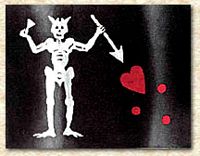The Golden Age of Piracy
Sources disagree about the exact dates of the Golden Age of Piracy, but most place it at the end of the 17th century and the beginning of the 18th century. Blackbeard, possibly the most well-known historical pirate, sailed during this period. Calico Jack, who sparked controversy by allowing women pirates Anne Bonny and Mary Reade on his ship, was a Golden Age pirate as well.
Piracy peaked between 1690 and 1730 for several reasons. There were lots of ships to attack -- they carried slaves from Africa to the Americas and sugar, rum and other goods from the Americas to Europe. Additionally, the English and Dutch governments had used privateers during the War of the Spanish Succession. When this war ended in 1714, many privateers turned to piracy rather than accepting a less affluent life as a sailor on a merchant ship. New colonies on the American coast did not generally have the means to defend themselves against pirate attacks, so they became easy targets.
Advertisement
Golden Age pirates had many of the qualities that people associate with pirates today:

- Flags: The Jolly Roger made its first appearance in the early 18th century. Before that, pirates often sailed under false colors, flying the same flag as nearby ships in order to gain captains' trust. Pirates used distinctive flags to threaten and intimidate their victims, who would often surrender without a fight. The pirates could then gain control of an undamaged ship without any loss of ammunition or life.
- Clothes: Although they typically wore practical clothing that was well suited to life at sea, Golden Age pirates often had expensive, high-quality garments that they had taken as plunder from captured ships. The stereotypical pirate garb mimics the clothing that was popular during the Golden Age. You can see what this clothing looked like at the Costumer's Manifesto.
- Parrots: Pirate ships didn't necessarily have resident parrots who shrieked, "Pieces of Eight," but pirates did often capture parrots in order to sell them.
- Hooks and peg legs: Piracy was difficult, dangerous work, and pirates often lost limbs in battle or accidents. But two notable fictional characters have reinforced the idea of pirates with missing limbs -- Captain Hook from "Peter Pan" and Long John Silver from "Treasure Island." In addition, although most pirates were weathered and leathery, few were old. The challenges of a pirate's life meant that most were in their 20s.
- Armaments: Flintlock pistols were common during the Golden Age of Piracy. But they also weren't very reliable at sea -- salt and water could keep them from firing. Pirates often went into battle armed with multiple flintlock pistols, a machete-like cutlass and multiple daggers.
In the next section, we'll look at the types of ships pirates used.
